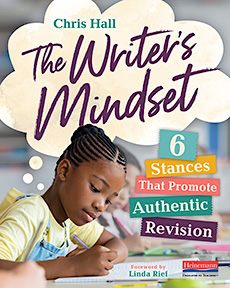Help Students Discover Their Writer’s Mindset
By Chris Hall

A few Junes ago, I was thinking back about my writing workshop, and I was getting the nagging feeling that something was amiss with the way I was teaching revision.
I often presented revision as something to face after the first draft was over. A stage in the writing process – a step right after drafting and just before editing. I had been taught to wait until after the first draft was complete to have my students revise, but that seemed too late.
When I looked at my students at their best – and at my own experience as a writer – I realized that revision was occurring throughout the writing, not just after the end. I saw it happening with my students throughout drafting – in micro- and macro-changes that writers were trying before, during, and after composing each line. My writers were stopping periodically to review and reread their words, making adjustments big and small along the way.
There was also something that didn’t sit right with the whole approach of writing process and workshop. There was certainly nothing wrong with teaching students that writing is a process (i.e., prewriting, drafting, revising, editing, publishing) and showing them the structures of the workshop model (e.g., minilessons, conferences, shares, and predictable writing times). The problem was where these approaches focused my gaze as an educator.
The way I had been taught writing process and workshop put my emphasis firmly on the writing. Makes sense, but it seemed to me that there were things to be learned at the other end of the pencil – in my students themselves.
When I saw my students embracing revision, it wasn’t just that they knew craft moves and had learned certain writing skills (important as those are). It was their willingness – and even enthusiasm – to revise. To identify lines that were working and build from them. To be aware of their own reactions as they were writing, not just at the end of a draft.
It was their openness to a new approach or tendency to take the perspective of a potential reader. Their ability to transfer one skill they had learned to a completely new genre or draft. Their willingness to take a risk in order to stretch themselves as writers.
I felt like I was stumbling upon a new definition for revision, by gazing at the students right in front of me. Revision was about what was happening in the mindset of the writer, during the writing process, not just on the page, after it was done.
Adopting a writing stance
Influenced by the mindset research of Carol Dweck (2006) and the Habits of Mind work of Arthur Costa and Bena Kallick (2008), I began to notice and name the behaviors my students were showing when we were in the thick of a culture of revision.
I was drawn to the term stance – coined by Kristine Mraz and Christine Hertz in A Mindset for Learning (2015) – because it implied a behavior my students could adopt, not a fixed, innate quality they either had or didn’t have. Like a ready stance in baseball (knees bent, glove out, eyes on ball), a writing stance indicated a conscious choice, a way of approaching revision that we could learn and practice until it became a part of us. Motor memory for writers.
But which behaviors – which stances – were most important for moving us beyond revision resistance? After I distilled elements from the Habits of Mind and other work, the key parts of a writer’s mindset revealed themselves. Following are the stances that emerged in my classroom and students:
Metacognition
Some students were aware of the decisions they were making in their drafts – what they were trying (their writing moves) and why they were trying them (their intentions). They were willing and able to see their writing, and their reactions to it, clearly and honestly – paying attention to what felt right and what sounded off in their emerging drafts. To the places in the writing that energized them or fell flat. To the lines that would be intriguing or confusing.
I could see metacognition in my student Alja when she was thinking out loud about her personal narrative: the mortifying time when she threw a snowball in an airport parking lot and it went awry, nearly causing her family to miss a flight. Alja felt uninspired by her first lines and decided they needed changing. Pausing middraft, she realized she wanted to leave her readers with questions, so she added some intriguing lines and held off on other information that could come later in the narrative.
Not only did Alja create a stronger lead, but her metacognition – her self-awareness about her writing during the process – would be a resource for her to use again and again, a little voice she could listen to and learn from.
Optimism
Some students were drawn to the strengths of their draft (rather than focused on its shortcomings) and built off what was already working. This optimism helped propel them forward through the hard work of revision. In looking at the positive aspects of their writing, these students often stayed hopeful, engaged, and persistent – even when they hit difficult spots in the process.
For example, there was Elly, whose quiet optimism shone through even as she struggled to describe an oyster shell for a nature poem she was writing. She read her drafts to peers, listened to their comments, and kept trying to look at her shell with new eyes and fresh metaphors.
The optimism I saw in students like Elly wasn’t some chipper, Pollyannaish attitude, but a tendency to invest their energy in what was working and to build from it. The persistence I witnessed wasn’t white-knuckle tenacity – a show-grit-through-the-misery approach – but a willingness to work through the challenges of revision because the writing was worth it.
Perspective-Taking and Connection with the Audience
I also noticed the students who could readily step into their readers’ shoes – to see their own writing from another perspective. They anticipated what their imagined audience might need or feel while reading their draft – the places where they might be confused, the background information readers would need for clarity, the details that would be most intriguing to them.
These students predicted their audience’s reactions, and they listened carefully to the actual feedback they received from readers during conferences. These were writers thinking like readers.
Perspective-taking was what made Shreya rethink what her script for a social studies presentation on Pearl Harbor needed. Her draft was written in first person – from the point of view of an American soldier facing the surprise attack – but she felt like her lines were too informational. Thinking like a reader, Shreya reflected that her script was overpacked with facts but emotionally empty. She stepped into the shoes of her soon-to-be audience, spurring some important changes to her script.
Flexible Thinking
I noticed students who would hold off on saying, “I’m done,” who remained open to new ideas, approaches, and feedback. They showed a curiosity and confidence to try something novel with their writing – and a humility to recognize these great ideas might come from others.
Perhaps none of my students showed as great a change in flexible thinking as Lea. She started the year prickly and closed off when approached with virtually any comment about her writing. Lea excitedly churned out ten-page fantasy stories, but if a classmate voiced any question or confusion, she bristled, “I like it the way it is!”
Teaching Lea reminded me what a vulnerable act writing is and how it’s no easy task for a writer to trust their readers. It takes time to build a relationship, and it takes feedback that’s truly supportive and helps writers to find their own way. Kids like Lea – all of us, really – need to know that revision doesn’t mean deference or submission, but a creative back-and-forth between fellow writers.
As the year progressed, Lea’s feelings about revision shifted as she began to see its value and trust us as readers. Taking a more open stance and listening to other ideas was a gradual – and far from easy – process for Lea, but she came to see it was well worth the effort.
Transfer
There were students who were conscious of the wonderful writing skills and craft moves they had previously learned and were intentionally transferring these to new pieces and situations. For instance, Jack learned about adding interior monologue – a character’s inner thoughts – from one of his peers. Jack had read a piece by Alyssa, which included some conflicted and quite funny thoughts about agreeing to ride a terrifying roller coaster with her dad. After reading her story, Jack pinpointed what she had done (even if he struggled to name the craft move).
He then set out to use a similar approach in his piece about a scooter crash, a time when he misjudged a ramp at a skate park. Taking note of what he loved in Alyssa’s writing, Jack decided to add some powerful lines of interior monologue to his own draft – his thoughts about whether to attempt a dangerous landing or bail out on his scooter.
Risk-Taking
Other writers played with fresh ideas and willingly took risks to stretch beyond what they could already do. They allowed themselves to be vulnerable, pushing the boundaries of what they had tried before – experimenting with new genres, narrators, story structures, endings, and more. Rather than rushing to complete a draft, they were willing to live with uncertainty in order to play with possibility.
For example, there was Vincent, who took the risk to try something he had never done before as a writer: taking on a different point of view. For his poem, “Poison Ivy,” Vincent imagined the three-leafed scourge’s perspective: “I’m innocent / Don’t I look friendly? / I really love playing / …Maybe three might be your lucky number!”
Teaching about the writer’s mindset
Metacognition. Optimism and persistence. Perspective-taking and connection with our audience. Flexible thinking. Transfer. Risk-taking. Where could you begin teaching about a writer’s mindset this coming year? Which stance might you start with?
As you refill your teaching tank this summer, consider these possibilities for fostering metacognition with your student writers next year:
► Ask students to create a “writing selfie” to reflect on their writing identity. A writing selfie is a literary self-portrait in which students share who they are as a writer – their earliest writing memories, notable writing projects, their personal writing process, and more. What are some of their memories of writing in and out of school? Were the writing experiences mostly positive or negative? How do they feel as a writer? What inspires them to write, or what do they enjoy about writing? What makes writing hard or frustrating for them? What helps them as writers (and what doesn’t)?
Rather than giving a beginning-of-the-year survey, a selfie is a creative way for students to answer questions like these. Open up the options and allow students to choose different formats for their selfie – perhaps a letter, series of vignettes, poem, or graphic novel.
► Have students reflect on their revisions mid-draft with a “thoughtcast.” Rather than having students complete a process history at the end of a final draft, ask them to pause during drafting for a process present. Ask:
- How did you come up with this idea, or why did you decide to write about it?
- What’s going well so far? What lines or parts are you excited about?
- What are areas that don’t seem quite right, where you’re struggling to capture your ideas or emotions?
- What changes have you made so far? Why did you make them?
- What will you try next as a writer to revise this piece?
Questions like these focus students on what they are attempting in the here and now – and might try in the future. The reflections can be informal (e.g., an exit slip or turn-and-talk), but one engaging way to capture them is with a screencast.
Using free online screencasting tools (such as Screencastify), have your students create a thoughtcast – a screencast describing the moves and decisions they are making in real time on a draft. Have them open a draft on a laptop and, using the screencasting software, respond to the questions above using audio or video commentary.
► Model your own metacognition as a writer. We know it’s important to write alongside our students. Perhaps it’s even more critical to share our inner writing voice – the countless decisions we’re making as writers when we’re revising. Use a think aloud to show the choices you are grappling with as writer on a fresh and unpolished draft (just as we ask our students to do).
Project your piece and review it aloud in front of your students, responding to some of the same questions above. Which lines leave us energized? What moves are we trying and why? What aspects of our draft are we still unsure about? What might we try next? Answering these draws the curtain back on our own internal dialogue as writers. It makes our unseen writing moves visible for students and helps them envision their own.
Read our review of The Writer’s Mindset
by MiddleWeb contributor Anne Anderson

Chris served as a Heinemann Fellow, researching innovative writing practices within a cohort of dynamic educators from across the country. You can find him on Twitter at @CHallTeacher.
For more information about the strategies and ideas shared in this article, check out his new book for grades 3-8, The Writer’s Mindset: 6 Stances That Promote Authentic Revision (Heinemann, 2022).





































Wonderful! This article has excellent points about the writing process.